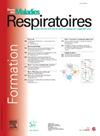[抗纤维化治疗:10年后我们在哪里?]]
IF 0.5
4区 医学
Q4 RESPIRATORY SYSTEM
引用次数: 0
摘要
纤维化间质性肺病(ILD)是严重的呼吸系统疾病,可导致呼吸衰竭和死亡。在过去的十年中,抗纤维化治疗已经取得了显著的进展,并得到了广泛的应用。最新进展:吡非尼酮和尼达尼布已被批准用于治疗特发性肺纤维化(IPF),而只有尼达尼布被批准用于治疗系统性硬化症相关的ILD和进行性肺纤维化(PPF)。这两种药物有助于减少这三种适应症特征的用力肺活量(FVC)下降,并降低IPF和PPF患者的死亡率、急性加重和生活质量损害。观点:对这些治疗的耐受性仍然是主要的挑战,促使评估替代给药途径,如吸入。许多正在进行的临床试验和令人鼓舞的3期研究结果预计将导致新的抗纤维化分子的批准。结论:抗纤维化治疗已被证明对IPF和PPF的治疗至关重要。处方应与患者共同决定,即使在老年人中,只要有专门的支持,也可以在早期阶段考虑。本文章由计算机程序翻译,如有差异,请以英文原文为准。
Les traitements antifibrosants : où en sommes-nous 10 ans après ?
Introduction
Les pneumopathies interstitielles diffuses (PID) fibrosantes sont des pathologies respiratoires sévères pouvant conduire à l’insuffisance respiratoire et au décès. Au cours des dix dernières années, les traitements antifibrosants ont constitué une avancée thérapeutique majeure et sont désormais largement utilisés.
État des connaissances
La pirfenidone et le nintedanib sont indiqués dans le traitement de la fibrose pulmonaire idiopathique (FPI), alors que seul le nintedanib est indiqué dans la PID de sclérodermie systémique et des fibroses pulmonaires progressives (FPP). Ils permettent de diminuer le déclin de la capacité vitale forcée (CVF) pour ces 3 indications et de réduire la mortalité, les exacerbations aiguës, et la détérioration de la qualité de vie au cours de la FPI et des FPP.
Perspectives
Un des enjeux majeurs reste la tolérance des traitements amenant à évaluer des modalités de prise différentes comme la voie inhalée. De nombreux essais thérapeutiques sont en cours et des résultats encourageants d’études de phase 3 devraient aboutir à la prescription de nouvelles molécules anti-fibrosantes.
Conclusion
Les antifibrosants ont montré leur place importante dans le traitement de la FPI et des FPP. Leur prescription repose sur une décision partagée avec le patient, et peut être proposée précocement et chez des sujets âgés, sous réserve d’un accompagnement dédié.
Introduction
Fibrosing interstitial lung diseases (ILD) are severe respiratory conditions that can lead to respiratory failure and death. Over the past decade, antifibrotic therapies have represented a significant therapeutic advancement and are now widely used.
State of the art
Pirfenidone and nintedanib have been approved for the treatment of idiopathic pulmonary fibrosis (IPF), while only nintedanib has been approved for systemic sclerosis-related ILD and progressive pulmonary fibrosis (PPF). Both drugs help to reduce the decline in forced vital capacity (FVC) characterizing these three indications and to decrease mortality, acute exacerbations, and quality of life impairment in patients with IPF and PPF.
Perspectives
Tolerance to these treatments remains a major challenge, prompting evaluation of alternative administration routes, such as inhalation. Numerous ongoing clinical trials and encouraging results from phase 3 studies are expected to lead to the approval of new antifibrotic molecules.
Conclusions
Antifibrotic therapies have proven to be crucial in the management of IPF and PPF. Prescription should be a shared decision with the patient and may be considered at an early stage, even in elderly individuals, provided that dedicated support is avaialble.
求助全文
通过发布文献求助,成功后即可免费获取论文全文。
去求助
来源期刊

Revue des maladies respiratoires
医学-呼吸系统
CiteScore
1.10
自引率
16.70%
发文量
168
审稿时长
4-8 weeks
期刊介绍:
La Revue des Maladies Respiratoires est l''organe officiel d''expression scientifique de la Société de Pneumologie de Langue Française (SPLF). Il s''agit d''un média professionnel francophone, à vocation internationale et accessible ici.
La Revue des Maladies Respiratoires est un outil de formation professionnelle post-universitaire pour l''ensemble de la communauté pneumologique francophone. Elle publie sur son site différentes variétés d''articles scientifiques concernant la Pneumologie :
- Editoriaux,
- Articles originaux,
- Revues générales,
- Articles de synthèses,
- Recommandations d''experts et textes de consensus,
- Séries thématiques,
- Cas cliniques,
- Articles « images et diagnostics »,
- Fiches techniques,
- Lettres à la rédaction.
 求助内容:
求助内容: 应助结果提醒方式:
应助结果提醒方式:


